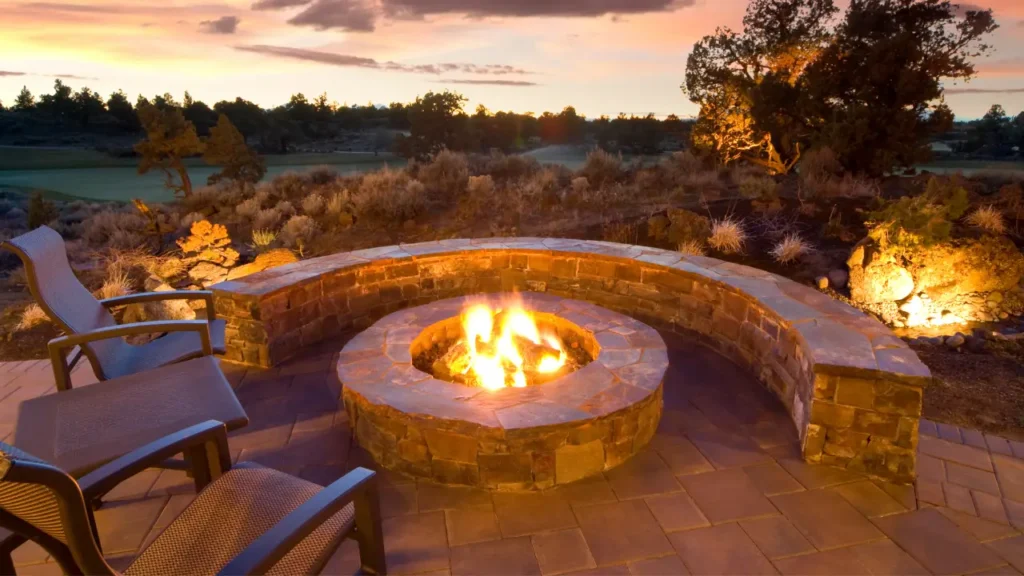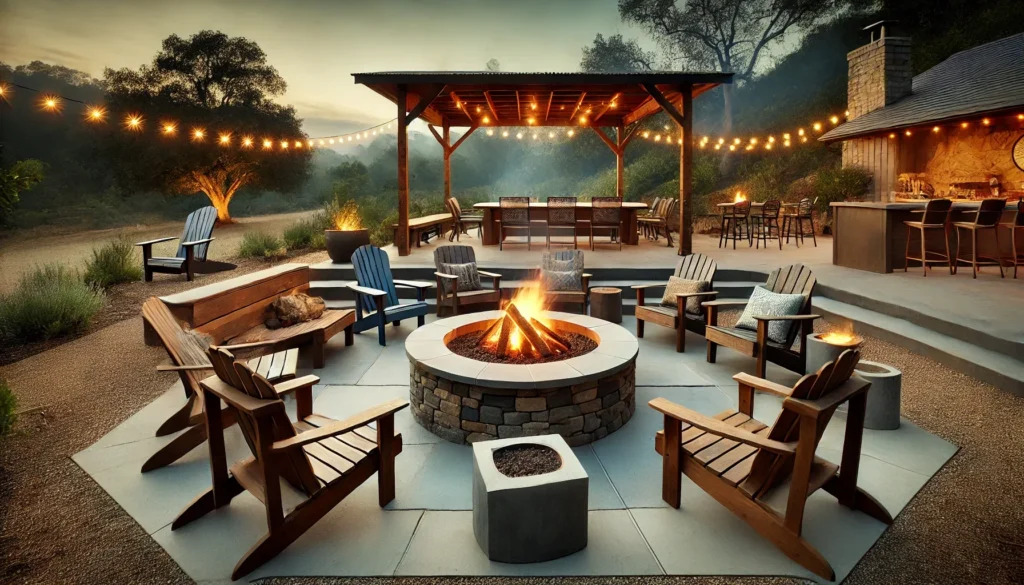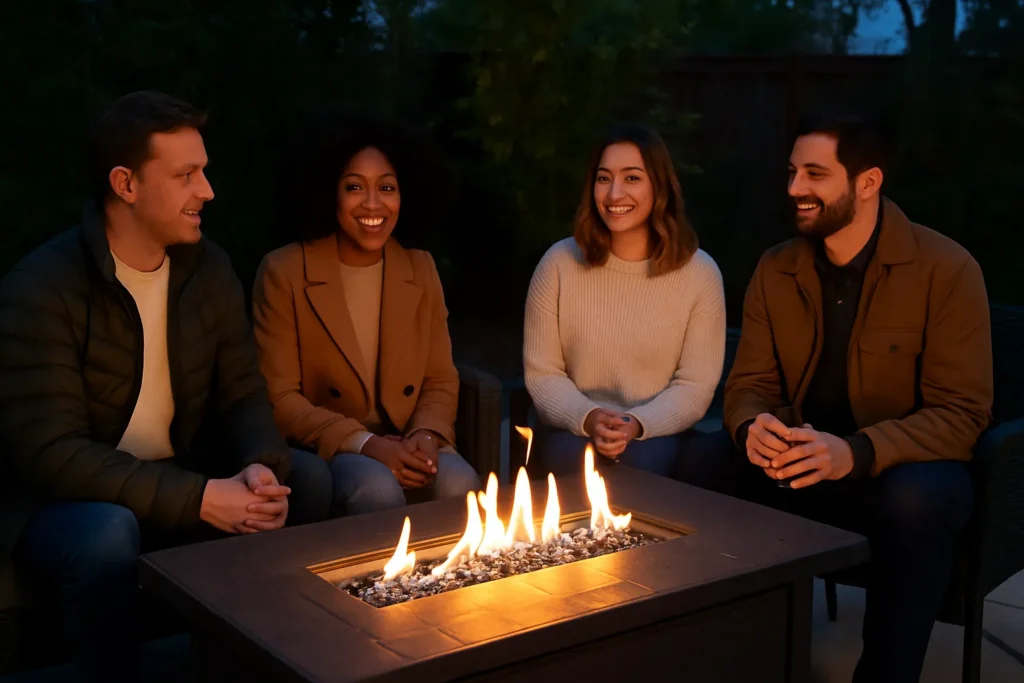A smokeless fire pit isn’t some magical invention—it’s a carefully engineered outdoor heating device designed to burn wood (or other fuels) more efficiently so that minimal smoke is produced. The secret lies in how it manages airflow and combustion.
Instead of letting the fire smolder with incomplete burning, a smokeless fire pit encourages a hotter, cleaner burn by introducing extra oxygen to the flames, allowing particles that would normally escape as smoke to be consumed instead.
What Makes a Fire Pit Smokeless? The Technology Behind Smokeless Fire Pits
The Double-Wall Design and Airflow System
The hallmark feature of a smokeless fire pit is its double-wall construction. This design channels air between two layers of metal, heating it as it rises.
The preheated air is then released through small holes near the top of the fire pit, feeding oxygen back into the flames from above.
This process isn’t just clever engineering—it’s essential. By adding oxygen at the right point, the fire burns hotter and consumes more of the leftover smoke particles before they can escape.
The Secondary Combustion Process
The secondary combustion is where the magic happens. In traditional fire pits, smoke simply escapes into the air. In smokeless models, the rising smoke passes through a superheated oxygen-rich zone near the top. This reignites the smoke particles and gases, burning them before they leave the pit.
This extra burn stage dramatically reduces visible smoke and boosts heat output. It’s like giving your fire a “second wind” that cleans up its own mess before it reaches your nose.
Materials Used in Smokeless Fire Pits
High-Temperature Resistant Metals
Smokeless fire pits need to handle extreme heat—sometimes over 1,000°F—without warping. Stainless steel is a popular choice because it resists rust, holds heat well, and is easy to clean.
High-grade carbon steel is another option, often used in premium fire pits for its durability and heat retention.
Insulating Layers and Heat Retention
Some designs incorporate insulation between walls, helping retain heat for more efficient secondary combustion. This ensures that the upper burn zone stays hot enough to incinerate smoke particles even when the main flames are lower.
Heat retention also means more warmth for people gathered around, which is a nice bonus during chilly evenings.
How Secondary Combustion Works in Detail
One of the key features that makes a smokeless fire pit so effective is the pre-heating of incoming air before it reaches the flames. In a traditional fire pit, cold air enters from below or the sides, and while it helps feed the fire, it also cools the combustion zone slightly, leading to incomplete burning.
Smokeless fire pits take a different approach. They have a carefully engineered channel system inside the double walls where incoming air travels upward, getting hotter as it moves. By the time it’s released through the upper vent holes, it’s already superheated—sometimes by hundreds of degrees.
This hot oxygen-rich air instantly ignites unburned particles and gases rising from the primary fire, turning what would have been smoke into additional flames. Not only does this improve efficiency, but it also creates a beautiful “dancing flame” effect near the rim, adding to the fire pit’s visual appeal.
The Role of Oxygen in Reducing Smoke
Oxygen is the fire’s best friend. Without enough of it, even the hottest fire will start producing smoke. In a smokeless fire pit, oxygen is supplied in two stages:
- Primary Combustion Air – Feeds the main fuel at the base of the fire.
- Secondary Combustion Air – Introduced at the top to reignite smoke particles.
This two-tier oxygen system ensures that almost all the combustible material is consumed before it escapes. It’s the difference between having a fireplace that belches smoke and one that burns clean and hot.
By using more oxygen efficiently, smokeless fire pits achieve a cleaner burn without needing chemical accelerants or forced air systems.
Fuel Type Preferences To Make Your Fire Pit Smoke Less
Smokeless fire pits can run on various fuels, but the two most common are wood logs and wood pellets.
- Wood logs give that traditional campfire feel and are easier to source locally.
- Pellets offer a very consistent burn and are easier to store, but they may not be as readily available in remote areas.
Some models are designed to burn both, giving you flexibility. Pellets tend to produce even less smoke because they’re kiln-dried and uniform in size, but many people still prefer the crackle and aroma of natural logs.
DIY Smokeless Fire Pit Design
Tools and Materials Needed
Building your own smokeless fire pit is a rewarding project if you enjoy hands-on work. You’ll need:
- Two metal barrels or rings (one slightly smaller to fit inside the other)
- High-temperature drill bits for airflow holes
- Heat-resistant paint (optional)
- Basic hand tools like a drill, grinder, and measuring tape
Step-by-Step Construction Guide
- Create the Double Wall – Place the smaller barrel inside the larger one, leaving a gap of about 1–2 inches for airflow.
- Drill Airflow Holes – Make lower holes for primary air intake and upper holes near the rim for secondary combustion air.
- Secure the Structure – Ensure the barrels are firmly positioned to prevent shifting during use.
- Test and Adjust – Burn a small fire to see how it performs, and enlarge or add holes if smoke levels are higher than desired.
A DIY smokeless fire pit may not be as polished as a commercial version, but it can still deliver a low-smoke experience when built correctly.
Safety Tips for Using Smokeless Fire Pits
Even though smokeless fire pits produce less smoke, they still produce heat and embers. Place your pit on a non-flammable surface—like gravel, stone, or concrete—at least 10 feet away from buildings, fences, or overhanging branches.
Avoid placing it directly on wooden decks unless you have a heat shield or protective base.
Only burn untreated, natural wood or approved fuel pellets. Avoid painted, stained, or chemically treated wood, as burning these can release toxic fumes.
Never use gasoline or lighter fluid to start your fire—these can cause dangerous flare-ups. Instead, use natural fire starters like wax-coated sticks or fatwood.
You May Also Like To Read:
FAQs
1. Are smokeless fire pits completely smoke-free?
No fire is 100% smoke-free, but smokeless fire pits drastically reduce visible smoke compared to traditional pits by burning fuel more efficiently.
2. Can I cook over a smokeless fire pit?
Yes, many models are designed with cooking accessories like grates or planchas. Just make sure to use untreated wood or pellets for safety.
3. Do smokeless fire pits require special wood?
No, but using dry, seasoned hardwood will give you the cleanest burn with the least smoke.
4. How long does a smokeless fire pit last?
With proper care—like cleaning ash, preventing rust, and avoiding extreme weather exposure—quality models can last for many years.
5. Are smokeless fire pits worth the investment?
If you enjoy regular outdoor fires and want less smoke, more heat, and less cleanup, the investment pays off in comfort and convenience.
Affiliate Disclosure: Fireplaceadviser.com is a participant in the Amazon Services LLC Associates Program. We may earn a commission when you click on certain links on this site and purchase.

Hello!! I am Jamal Khan. I often fix my home electric heaters and gas stove problems and research the common issues in the heating units to improve my knowledge and expertise. The aim of establishing fireplaceadviser.com is to share my expertise and knowledge with my audience.

















